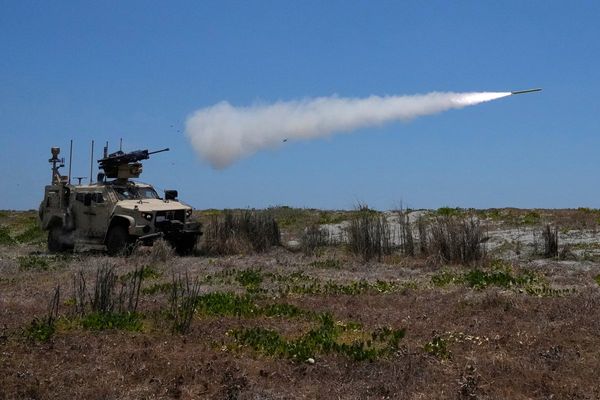
There is a comforting bucolic vibe to the term “gleaning”, which refers to gathering leftover crops after harvesting. The central theme of Ireland’s contemporary art biennale, EVA International, suggests thrifty farming and caring for the land. But the assumption shatters when you see paintings by the Ukrainian artist Kateryna Aliinyk: vegetables resemble grenades and their roots are like mangled entrails in a dark, disturbing underworld.
It is an abrupt warning that the 40th EVA International, which starts in Limerick on Thursday, uses the concept of gleaning to ask disquieting questions about what we sow, reap and leave buried.
Aliinyk’s work reflects her visits to parts of the Donbas region that are occupied by Russian forces and in many places abandoned to nature. “On my way there I always thought: why does this landscape look so scary even if it looks almost the same? Probably because beneath this flourishing greenery we most likely will find evidence of war crimes.”
Ireland’s principal contemporary arts festival, one of Europe’s oldest, interrogates the war, the climate crisis, the environment, citizenship and censorship among other themes. It runs until 29 October with contributions from more than 50 artists in 17 venues across Limerick,, including civic arts institutions, a primary school, a cathedral, a university and a vegetarian cafe.

There are just a handful of Ukrainian artists, but a sense of urgency about the Russian invasion and other global challenges pervades many exhibitions.
“It’s still quite a conventional exhibition – we have sculptures, watercolours – but embedded is this militant spirit,” says Sebastian Cichocki, who curated the guest programme. He wishes to reclaim propaganda as a term. “The original meaning of the word was to cultivate something. I’m interested in ways of propagating and disseminating ideas using artistic tools. This is like our duty.”
Cichocki is chief curator at the Museum of Modern Art in Warsaw and a member of The Sunflower, a solidarity group that counters Russian propaganda. “What’s so powerful about good political art is it’s a trap but you don’t know it, it triggers your emotions, it propagates ideas,” he says. “Art is quite like a sharp razor, it’s really efficient. You can use it for good or for worse.”
The guest programme, titled The Gleaners Society, includes contributoions from Ireland, Japan, Belgium, Bangladesh, Britain, South Korea and the US.
As a metaphor, gleaning could apply to the host city. Tucked into western Ireland with just 100,000 urban residents, Limerick has to forage for attention and resources otherwise harvested by Dublin and Cork. The biennale started in 1977, making it relatively venerable, yet it still needs to hustle for limelight otherwise taken by contemporary art festivals in Glasgow and Liverpool.
It does not help that Irish media tend to favour other areas of the arts, says Úna McCarthy, the director of Limerick’s Gallery of Art, which hosts EVA events. “Ireland has an uneasy relationship with contemporary art. We’re more comfortable with literature and performing arts.”
The paucity of glitz and sponsorship has at least avoided a boom and bust cycle and kept the biennale feeling young, says Matt Packer, EVA’s director. “I joke that EVA’s success is partly from being misunderstood over the past 45 years.”

The festival embeds in multiple venues – more than 150 over the decades, including a sports bar, a bacon shop, a friary, a boutique and a handball alley – without seeking to disguise them, says Packer. “This isn’t a show for fantasies and to escape to another reality, it’s about showing lived experiences. We take the city as we find it and use its existing infrastructure. We play into it rather than create a portal to another world.”
The biennial has to work hard for visibility even in Limerick, says Packer. “On a good day it feels owned by the city but I wouldn’t deny we struggle to get funding. The local council has not always known what to do with us.”
Cichocki, the curator, says he did not wish to treat art from Ukraine as a fashion or a trend but as something integral to wider concerns. “This exhibition is about our urgencies, our crises.”
There are three films from Freefilmers, a collective of artists originally from Mariupol. My Favourite Job, by Sashko Protyah, is an experimental road movie about volunteers who organised evacuations as Russian forces closed in. “They speak about it normally, even with sarcasm and irony,” says Natasha Tseliuba, a member of Freefilmers. Her main hope for the biennial: “Keep attention and support (on) Ukraine.”
The other two films predate Mariupol’s obliteration in 2022, giving an elegiac sense of a doomed city. In Metawork a man fights societal apathy by growing sunflowers on a balcony. In Revitalization of Spaces – an ironic reference to gentrification – people explore abandoned buildings. The film is a good fit for a festival inspired by gleaning, says its co-director, Oksana Kazmina. “It is a collection of memories about places that are gone. We were visiting all these places, asking people if they would like them to be gentrified or stay like that, empty free places. Now they are non-places.”







